How Have the Grand National Fences Changed Since it Started?
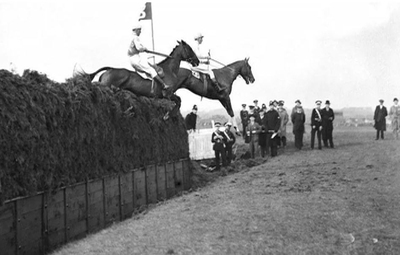 The fences at Aintree are what make the Grand National one of the most challenging tests over distance for any horse and rider in the world.
The fences at Aintree are what make the Grand National one of the most challenging tests over distance for any horse and rider in the world.
That goes for their number as well as their difficulty.
No race has more jumps to make than the Grand National, and some of them have been the location of events so momentous that they have even been named in honour of them; Becher’s Brook, Foinavon, The Chair, and so on.
These obstacles are mainstays in a race that has seen many changes over the years, but although it may not be immediately obvious, the fences themselves have gone through many changes too.
As the horse racing industry has become more safety conscious over the years, and as animal welfare has increasingly taken the spotlight, changes to the Grand National fences have been introduced to improve things.
These changes have involved everything from where the fences are, their height and the condition of the ground around them, and even what they are made of, so a lot has gone on.
It’s not easy to appreciate from afar just how tough a task it is to get over the Grand National fences, but the information in this article should give you a clearer picture of why it is the most challenging race of them all.
All About the Grand National Fences
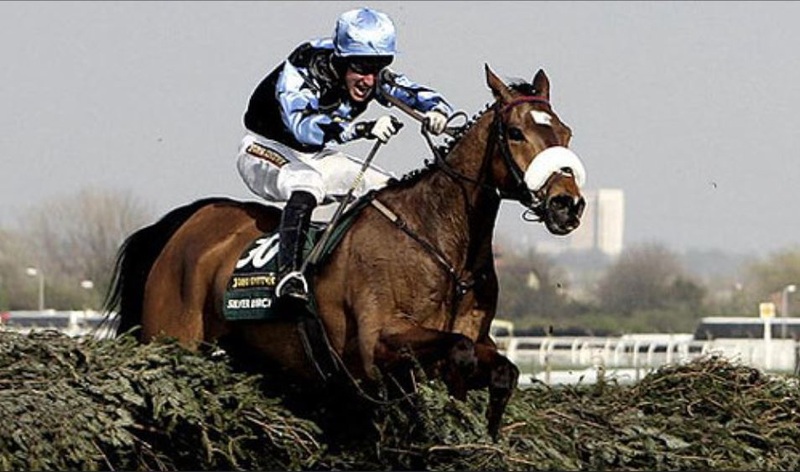
The Grand National is actually made up from 2 circuits of the course at Aintree, so although the race is said to have 30 fences, they are not 30 individual fences.
In actual fact, the course has 16 individual fences, 14 of which are jumped twice and the remaining 2 are only jumped once, giving 30 jumps in total.
The first circuit contains 16 fences, and the second circuit contains 14 fences.
Each jump is given a number, but since most of the fences are jumped twice, the majority of the fences have two numbers associated with them.
This is how they pair up, with the first number being the first circuit and the second being the second; you can also see details of each fence’s height and any other useful points of information:
| Fence# | Height/Width | Notes |
|---|---|---|
| 1 & 17 | 4ft 6in/2ft 9in | – |
| 2 & 18 | 4ft 7in/3ft 6in | – |
| 3 & 19 | 5ft 0in/10ft 6in | Open ditch on take-off side |
| 4 & 20 | 4ft 10in/3ft 0in | – |
| 5 & 21 | 5ft 0in/3ft 6in | – |
| 6 & 22 | 4ft 10in/7ft 6in | Becher’s Brook, named after Captain Martin Becher who was unseated here in the first ever Grand National, in 1839. |
| 7 & 23 | 4ft 6in/3ft 0in | Foinavon Fence, named after the only horse to clear it in 1967, Foinavon, who was in last place but went on to win. |
| 8 & 24 | 5ft 0in/7ft 0in | Canal Turn, thusly named because of its proximity to the canal, and the sharp left hand turn immediately after it. |
| 9 & 25 | 5ft 0in/7ft 0in | 5ft 6in brook on landing side. |
| 10 & 26 | 5ft 0in/3ft 0in | – |
| 11 & 27 | 4ft 10in/10ft 0in | Open ditch on landing side. |
| 12 & 28 | 5ft 0in/3ft 0in | This is where runners join the main circuit of the course on the 2nd circuit of the race. |
| 13 & 29 | 4ft 7in/ft 0in | – |
| 14 & 30 | 4ft 6in/ft in | – |
| 15 | 5ft 2in/ft in | The Chair. First circuit only. The most challenging fence of all, with a 5ft ditch before the jump and a raised landing side. The narrowest fence of the race. |
| 16 | 2ft 6in/ft in | Water Jump. First circuit only. Water on landing side. |
So some of them are pretty fearsome – there’s a reason that only about half the field finish the race in any given year.
So that’s a little bit of general info about the fences, but has the layout always been the same, and have fences themselves changed at all?
Fence Movements, Adjustments, and Improvements
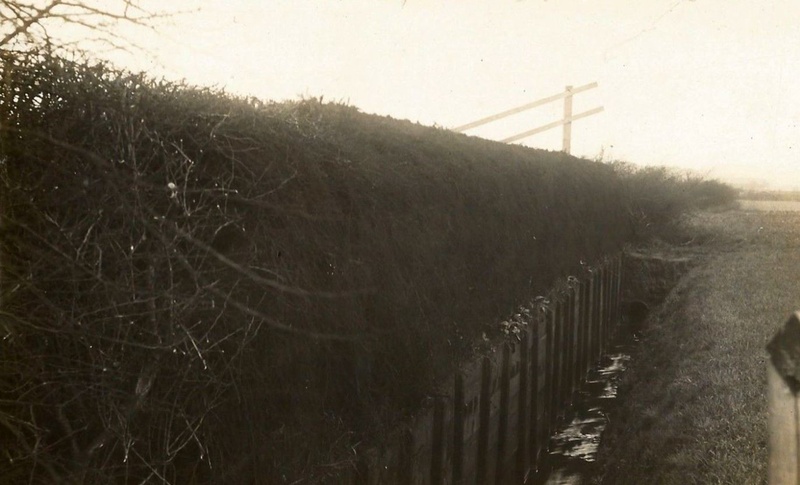
Since the race is almost 200 years old, information on changes to the fences in the earliest days of the Grand National in sparse, but if they were anything like the changes made in the last 100 years, they will have been sporadic.
This means that, unlike sweeping rule changes such as how many horses can compete in the race, changes to the fences have mostly come piecemeal, on an individual case by case basis.
However, there have been a few broader changes that have impacted every fence on the course, and we will go into a bit more detail on those in the next section.
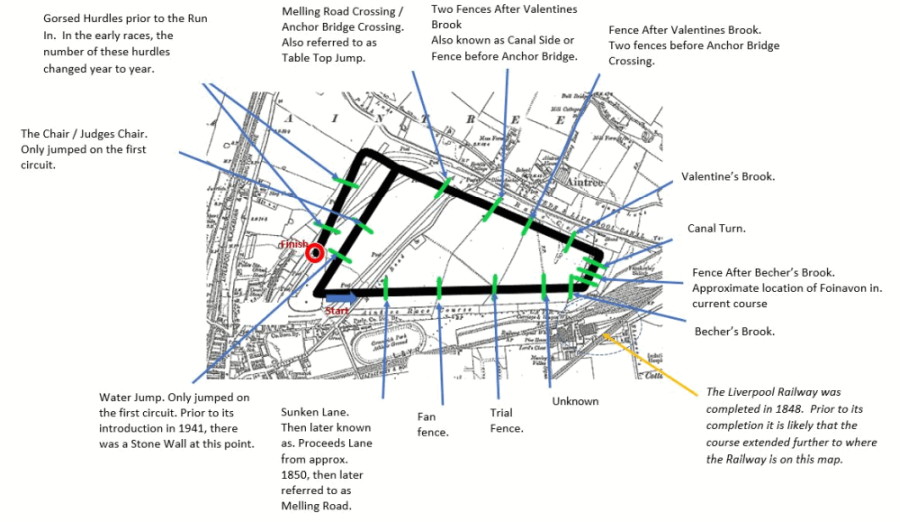
For now though, the major changes to fences that we know of have been listed below:
- 1839 – The first Grand National, when Captain Becher was unseated at fence 6, which has been named Becher’s Brook ever since. At this point, many of the jumps were real countryside obstacles marked with flag, such as farmers gates, real stone walls, hedges, and brooks.
- 1845 – Stone wall obstacles removed and replaced.
- 1860s – Around this time, the fences started to become higher and more challenging.
- 1888 – Fences 1/17 and 2/18 moved closer to the start to reduce speed of horses when going over them.
- 1930s – Fence known as The Monument is renamed The Chair, after the racecourse judge was positioned there in a high chair in order to be able to judge the distance between horses.
- 1954 – Modifications to the landing side of Becher’s Brook.
- 1987 – More modifications to the landing side of Becher’s Brook.
- 1990 – The brook at Becher’s Brook was all but filled in, and the camber made less of a slope.
- 2009 – Bypass routes were introduced to all fences, so that a jump could be skipped if there was a problem such as an injury from a previously fallen horse still on the course.
- 2011 – Fence 1/17 had the landing area levelled to smooth out undulations.
- 2012 – What was left of the ditch at Becher’s Brook was raised and levelled. Fence 4/20 was also reduced in height by 2 inches. Fences 4/20 ,5/21 , and 13/29 had their landing areas levelled to smooth out undulations. The start was moved forward 90 yards away from the crowds to help the horses stay calm.
- 2013 – All fences had their timber cores replaced with ‘plastic birch’, a much more forgiving material
- 2024 – First fence moved 60 yards closer to the start to reduce horse’s speed in early stages. Fence 11/27 height reduced by 2 inches.
As you can see, the most sweeping and significant changes came around 2012/2013, and we will go into that in more detail below.
Fence Construction
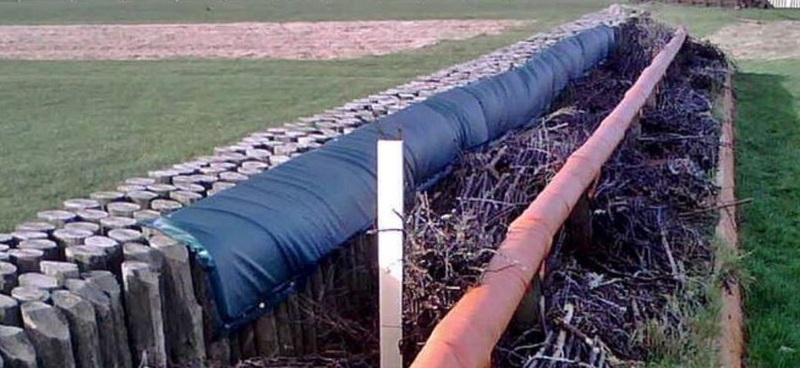
To begin with, the Grand National fences were more natural obstacles – one was a real stone wall for a while – but over the years the obstacles have been softened.
They may not look all that much different to 30 years ago, because the majority of what we can see as punters is the spruce branches that sit atop the fences, and these have not changed.
It’s what they are built on top of that has been modernised.
Up until 2013, the fences were made from a core of wooden stakes topped with spruce branches to a minimum depth of 14 inches. It offered some flexibility to the horses but was still fairly dangerous if hit.
In 2011, the BHA and Aintree conducted a 3-year research and development programme looking into alternative construction methods to make the fences more forgiving when horses made mistakes.
The result was a much smaller core, with 18 inches of plastic birch on top of it, which was then topped with natural spruce to a minimum depth of 14 inches as before.
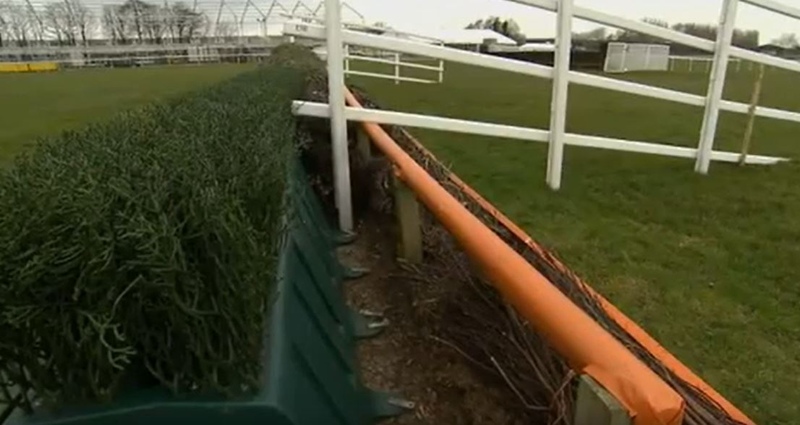
This synthetic birch was much safer if horses made contact with it, and also meant that they could technically jump lower without ‘hitting’ anything solid. Not that the horses would know that as the obstacles still look the same height.
You can think of it like jumping full speed through a 4ft sheet of plasterboard and through a 4ft sheet of paper; you’ll get through them both but one will hurt a lot more than the other.
The fences also have orange toe boards to give the horses and the jockeys a clear indication of where the fence starts, and these were increased in height to 14 inches to improve their visibility, while the guard rail further up has for a long time been made of padded PVC instead of the original solid timber.
So the way the fences are constructed has actually changed a lot since the early days, with many of the harder more robust materials being replaced with less painful alternatives, and improvements to visual aids too.
Have the Changes to Fences Made the Grand National Safer?

We can look at some data here to get a confident answer.
The big changes came in 2013, so if we look at the 10 Grand Nationals from then onwards and compare them with the 10 Grand Nationals prior, we can see any immediate impact.
Before
| YEAR | NO. OF FINISHERS | FELL OR BROUGHT DOWN | UNSEATED RIDER | REFUSED | PULLED UP | OTHER | FATALITIES |
|---|---|---|---|---|---|---|---|
| 2003 | 14 | 6 | 10 | 1 | 9 | 0 | 1 |
| 2004 | 11 | 12 | 7 | 1 | 8 | 0 | 0 |
| 2005 | 21 | 5 | 6 | 1 | 6 | 1 | 0 |
| 2006 | 9 | 11 | 6 | 2 | 12 | 0 | 1 |
| 2007 | 12 | 9 | 5 | 2 | 12 | 0 | 1 |
| 2008 | 15 | 11 | 8 | 0 | 6 | 0 | 1 |
| 2009 | 17 | 11 | 3 | 1 | 7 | 1 | 1 |
| 2010 | 14 | 10 | 8 | 0 | 7 | 1 | 0 |
| 2011 | 19 | 13 | 3 | 0 | 5 | 0 | 2 |
| 2012 | 15 | 13 | 7 | 1 | 4 | 0 | 2 |
| Average | 14.7 | 10.1 | 6.3 | 0.9 | 7.6 | 0.3 | 0.9 |
After
| YEAR | NO. OF FINISHERS | FELL OR BROUGHT DOWN | UNSEATED | REFUSED | PULLED UP | OTHER | FATALITIES |
|---|---|---|---|---|---|---|---|
| 2013 | 17 | 2 | 6 | 1 | 14 | 0 | 0 |
| 2014 | 18 | 8 | 6 | 0 | 7 | 1 | 0 |
| 2015 | 19 | 9 | 2 | 0 | 9 | 0 | 0 |
| 2016 | 16 | 5 | 6 | 0 | 12 | 0 | 0 |
| 2017 | 19 | 3 | 5 | 0 | 13 | 0 | 0 |
| 2018 | 12 | 8 | 5 | 0 | 13 | 0 | 0 |
| 2019 | 19 | 5 | 2 | 0 | 14 | 0 | 1 |
| 2021 | 15 | 5 | 4 | 1 | 15 | 0 | 1 |
| 2022 | 15 | 7 | 7 | 0 | 11 | 0 | 2 |
| 2023 | 17 | 6 | 9 | 0 | 7 | 0 | 1 |
| Average | 16.7 | 5.8 | 5.2 | 0.2 | 11.5 | 0.1 | 0.5 |
*The 2020 race did not take place due to Covid, so we have added 2023 into the data instead.
Clearly then, the changes have been effective.
The number of finishers has improved by 13.6%, the number of fallers has dropped on average by a massive 42.57%, and most importantly, the number of fatalities has dropped considerably – by 44.44%.
More horses are being pulled up now too, an average of 51.31% more to be precise, which points towards jockeys, trainers and owners taking a more cautious and considerate approach with their animals, and playing it safe rather than going for broke if they suspect the horse may have some sort of issue.
Some people have complained that the Grand National is no longer the race that it used to be, that it doesn’t offer the same challenge or as much spectacle; but few could argue that these improvements across the board are not welcome.
The changes that have been made to the fences have meant more finishers (so more competition until the end of the race), and fewer injuries and fatalities, which can only be a good thing. Yes, it probably does mean that the race is a little ‘easier’, but not by much.
It’s a balance, and it seems to be in a good place.
